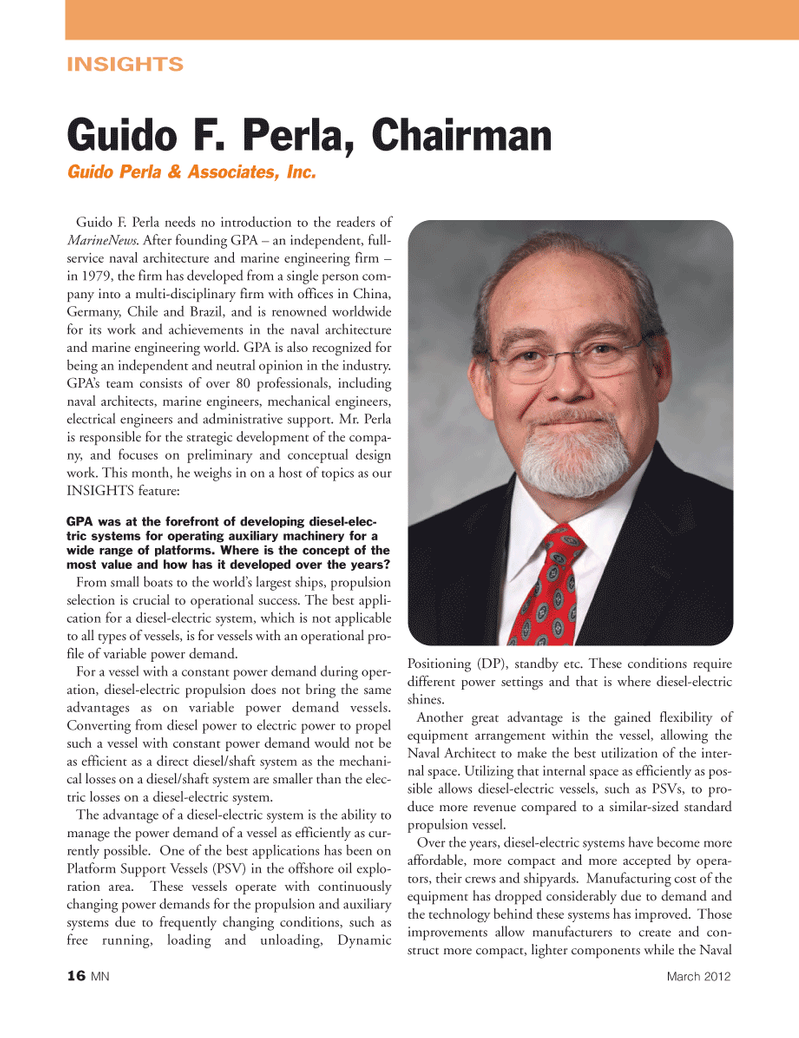
Page 16: of Marine News Magazine (March 2012)
Training & Education
Read this page in Pdf, Flash or Html5 edition of March 2012 Marine News Magazine
16MNMarch 2012 INSIGHTSGuido F. Perla needs no introduction to the readers of MarineNews . After founding GPA ? an independent, full- service naval architecture and marine engineering firm ? in 1979, the firm has developed from a single person com- pany into a multi-disciplinary firm with offices in China, Germany, Chile and Brazil, and is renowned worldwide for its work and achievements in the naval architecture and marine engineering world. GPA is also recognized for being an independent and neutral opinion in the industry. GPA?s team consists of over 80 professionals, including naval architects, marine engineers, mechanical engineers, electrical engineers and administrative support. Mr. Perla is responsible for the strategic development of the compa- ny, and focuses on preliminary and conceptual design work. This month, he weighs in on a host of topics as our INSIGHTS feature: GPA was at the forefront of developing diesel-elec- tric systems for operating auxiliary machinery for awide range of platforms. Where is the concept of the most value and how has it developed over the years?From small boats to the world?s largest ships, propulsion selection is crucial to operational success. The best appli- cation for a diesel-electric system, which is not applicableto all types of vessels, is for vessels with an operational pro- file of variable power demand. For a vessel with a constant power demand during oper- ation, diesel-electric propulsion does not bring the same advantages as on variable power demand vessels. Converting from diesel power to electric power to propel such a vessel with constant power demand would not be as efficient as a direct diesel/shaft system as the mechani- cal losses on a diesel/shaft system are smaller than the elec- tric losses on a diesel-electric system.The advantage of a diesel-electric system is the ability to manage the power demand of a vessel as efficiently as cur- rently possible. One of the best applications has been on Platform Support Vessels (PSV) in the offshore oil explo- ration area. These vessels operate with continuously changing power demands for the propulsion and auxiliary systems due to frequently changing conditions, such as free running, loading and unloading, Dynamic Positioning (DP), standby etc. These conditions require different power settings and that is where diesel-electric shines. Another great advantage is the gained flexibility of equipment arrangement within the vessel, allowing the Naval Architect to make the best utilization of the inter- nal space. Utilizing that internal space as efficiently as pos- sible allows diesel-electric vessels, such as PSVs, to pro- duce more revenue compared to a similar-sized standard propulsion vessel. Over the years, diesel-electric systems have become more affordable, more compact and more accepted by opera- tors, their crews and shipyards. Manufacturing cost of the equipment has dropped considerably due to demand and the technology behind these systems has improved. Those improvements allow manufacturers to create and con- struct more compact, lighter components while the Naval Guido F. Perla, Chairman Guido Perla & Associates, Inc.MN#3 (1-17):MN 2011 Layouts 3/2/2012 10:54 AM Page 16

 15
15

 17
17
